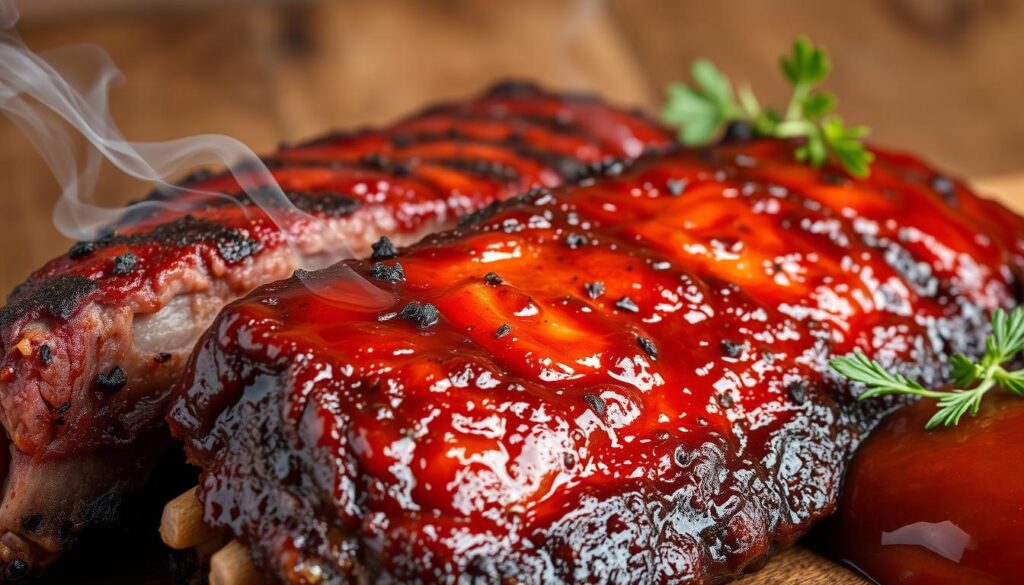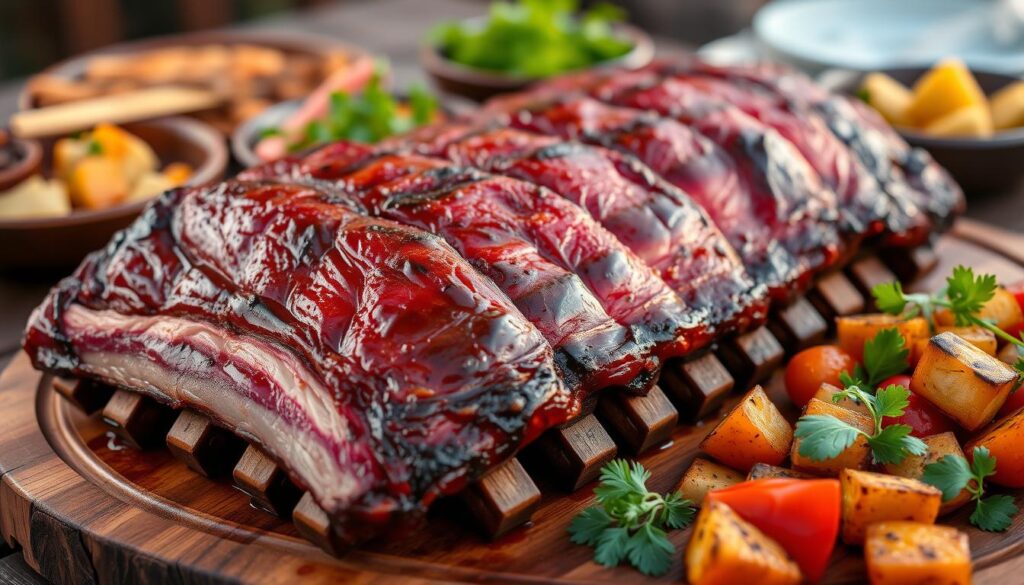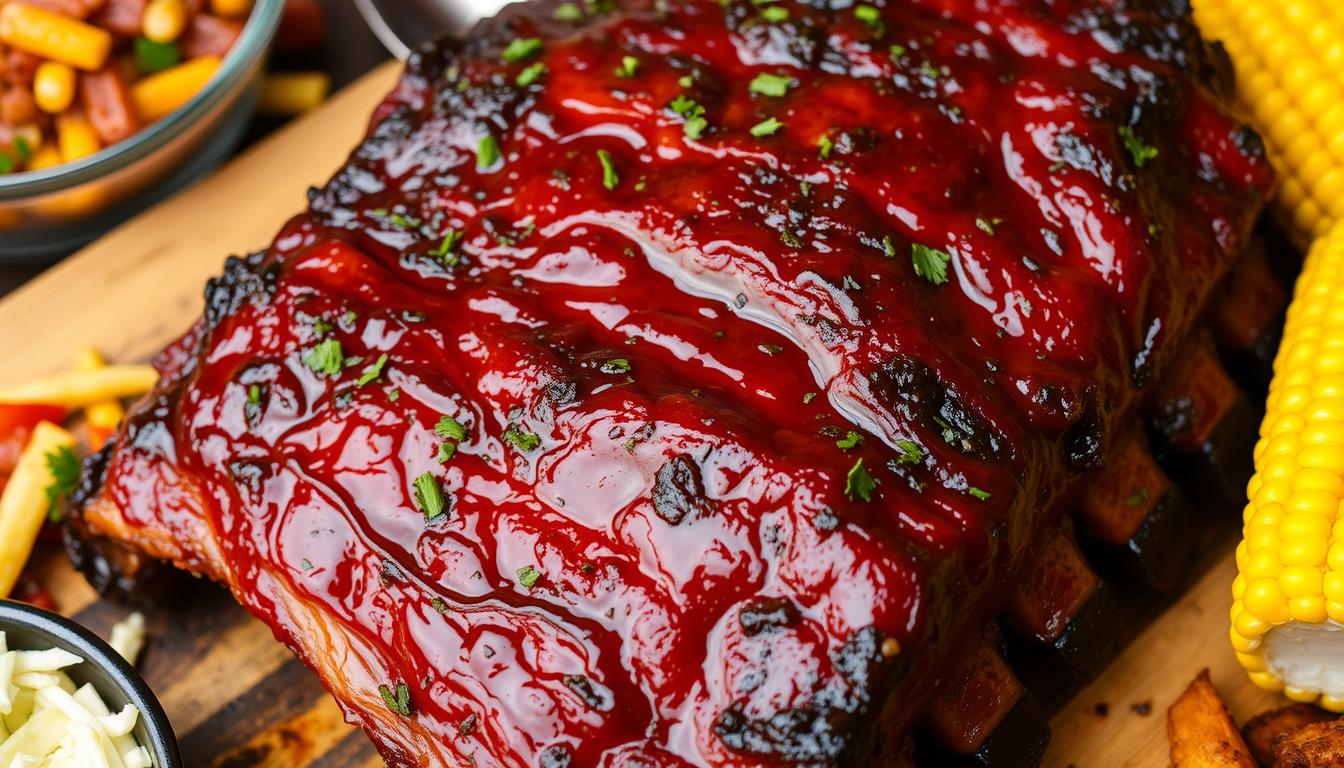Indulge in the ultimate barbecue experience with my secret recipe for delectable beef back ribs. Whether you’re hosting a backyard gathering or craving a comforting home-cooked meal, these tender, flavor-packed ribs are sure to impress. Join me as we explore the art of selecting, preparing, and cooking the perfect batch of beef back ribs that will leave your taste buds clamoring for more.
Key Takeaways
- Discover the unique qualities of beef back ribs that set them apart from other rib cuts
- Learn essential tips for selecting the best quality beef back ribs
- Master the art of creating a mouthwatering dry rub blend to enhance the natural flavors
- Explore various smoking techniques and temperature control methods for tender, fall-off-the-bone ribs
- Uncover the secrets to achieving that signature barbecue sauce flavor
Table of Contents
Why Beef Back Ribs Are the Ultimate Barbecue Experience
Beef back ribs are the top choice in barbecue. They offer a unique and unmatched dining experience. Your taste buds will want more after trying them.
Understanding Different Cuts of Ribs
Ribs come in many types, each with its own traits. Beef short ribs and beef back ribs are different. Beef back ribs are meatier and more tender, with lots of juicy flavor.
What Makes Back Ribs Special
The taste of beef back ribs is special because of their anatomy. They come from the upper rib cage, where the meat is more and has more fat. This fat makes the meat tender and flavorful, melting in your mouth.
Nutritional Benefits of Beef Ribs
- Packed with protein, offering essential amino acids for muscle growth and repair.
- Abundant in iron to promote healthy blood flow and oxygen distribution.
- Contains zinc, a key mineral for immune health and wound healing.
- Provides B vitamins, including niacin and vitamin B12, which support energy metabolism.
Enjoying beef back ribs is a true delight. They have unmatched flavor, tender texture, and are nutritious. They are the best choice for any barbecue meat lover. Get ready to taste the magic of beef back ribs at your next gathering.
Essential Equipment for Perfect Beef Back Ribs
To make delicious grilled ribs, smoked ribs, or barbecue ribs, you need the right tools. The perfect grill or smoker is key. You also need essential accessories to get that tender, smoky flavor.
Start with a top-notch grill or smoker. For grilled ribs, choose a gas or charcoal grill. It should keep a steady temperature and heat evenly. For smoked ribs, a dedicated smoker is best. It lets you add amazing wood-fired flavors.
Don’t forget a digital meat thermometer. It helps you check the barbecue ribs‘ internal temperature. You’ll also need sturdy tongs, a basting brush, and a rib rack or grill grate. These make handling and turning the ribs easy.
With the right tools, you’ll get better at grilling ribs, smoking ribs, and making delicious barbecue ribs. Invest in quality equipment. Your rib-cooking adventures will be a hit.
Selecting the Best Quality Beef Back Ribs
Choosing the right beef back ribs is key to a great barbecue. Look for these important factors to get the best meat for your dishes.
Signs of Fresh Meat
First, check the color of the ribs. They should be a bright, ruby-red. This means they’re fresh and of high quality. Stay away from dull, discolored, or greenish meat, as it’s old or stored wrong.
Optimal Size and Marbling
The best ribs have a good size and marbling. Marbling, the fat streaks, adds flavor and tenderness. Look for ribs with just the right amount of marbling. Too much fat makes the meat too greasy.
Where to Buy Premium Ribs
- Reputable local butchers or specialty meat markets: These places get their beef back ribs from top suppliers. They can give you great advice.
- Trusted online retailers: Many barbecue meat sellers ship nationwide. This is convenient for getting premium cuts.
- Farmer’s markets and local farms: Buying from producers ensures freshness and flavor in your beef ribs.
Follow these tips to find the tastiest beef back ribs for your next barbecue.
Creating the Perfect Dry Rub Blend
Start by making the perfect dry rub to elevate your beef ribs. This mix of spices and herbs adds flavor and creates a delicious crust. Let’s look at the key ingredients and how to mix a rib rub that will make everyone want more.
Essential Spices and Herbs
The base of a great rib rub is top-notch spices and herbs. Key ingredients include:
- Brown sugar: Adds sweetness and helps the rub caramelize.
- Smoked paprika: Gives a smoky flavor that goes well with beef.
- Garlic powder: Adds a savory, umami taste.
- Onion powder: Boosts the flavor depth.
- Chili powder: Adds a bit of heat that balances the sweetness.
- Dried thyme and oregano: Add earthy, herbal notes.
Mixing and Storage Tips
To mix a great rib rub, start with brown sugar and add spices slowly. Adjust the amounts to your liking. Store the rub in an airtight container in a cool, dry place to keep it fresh.
Application Techniques
Applying the dry rub is the last step for perfect ribs. Coat the ribs on all sides, rubbing the mix into the meat for even coverage. For the best taste, apply the rub hours or a day before cooking.
With the right dry rub and application, you’re set for delicious beef back ribs. They’ll impress your friends and family. Happy grilling!
Marinade Magic: Flavor-Boosting Liquid Options
Marinades can make your beef back ribs taste amazing. These liquids add lots of flavor. You can choose from acid-based or oil-based marinades. Just make sure the meat soaks up the flavors well before cooking.
Acid-Based Marinades
Acidic marinades, like vinegar or citrus, tenderize the meat. They add a tangy taste. Here are some rib marinade recipes to try:
- Balsamic and Garlic Marinade: Mix balsamic vinegar, minced garlic, Dijon mustard, and honey.
- Lemon-Herb Marinade: Combine lemon juice, olive oil, herbs like rosemary and thyme, and salt and pepper.
- Red Wine Marinade: Blend red wine, Worcestershire sauce, soy sauce, and your favorite spices.
Oil-Based Marinades
Oil-based marinades give a rich flavor. They use herbs, spices, and garlic for deep, savory tastes.
| Marinade Ingredients | Flavor Profile |
|---|---|
| Olive oil, garlic, oregano, basil | Mediterranean-inspired |
| Vegetable oil, brown sugar, smoked paprika, cumin | Smoky and sweet |
| Peanut oil, ginger, soy sauce, sesame seeds | Asian-fusion |
Choose your favorite marinade and let the ribs marinate for at least 2 hours. Or, marinate them for up to 24 hours for even more flavor.
Smoking Techniques for Tender Beef Back Ribs
Getting perfect smoked ribs is an art that needs detail and finesse. It doesn’t matter if you’re a pro pitmaster or just starting out. The secret to tender beef back ribs is mastering the smoking process.
Wood Selection Guide
The wood you choose greatly affects the taste of your ribs. Try different woods like:
- Hickory: It’s known for a strong, smoky taste, perfect for smoked ribs lovers.
- Mesquite: It gives a sweeter, intense smoke, great for beef back ribs.
- Oak: A versatile wood that offers a balanced smoke, ideal for all-around use.
Temperature Control Tips
Maintaining a consistent temperature is essential for tender ribs.
Timing and Doneness
Smoking beef back ribs takes time. Plan for 4 to 6 hours, depending on the ribs’ size. Check if they’re done by seeing if the meat pulls back from the bones and feels tender.

| Wood Type | Flavor Profile | Best For |
|---|---|---|
| Hickory | Robust, Smoky | Classic smoked ribs and barbecue |
| Mesquite | Sweet, Intense | Bolder flavor profiles |
| Oak | Balanced, Medium-Intensity | All-around versatile option |
The 3-2-1 Method Explained
Grilling barbecue ribs with the 3-2-1 method is a game-changer. This method ensures your rib recipes are cooked just right. They become incredibly tender, falling right off the bone.
Wrapping Techniques
The 3-2-1 method has three stages. First, the ribs are smoked low and slow for 3 hours. This step adds a smoky flavor.
Next, the ribs are wrapped in foil for 2 hours. This process tenderizes the meat and locks in moisture. Finally, In the final hour, the ribs are unwrapped. This lets the outside caramelize and get a delicious bark.
Moisture Management
- Wrapping the ribs in foil in the middle stage keeps them moist. This prevents the meat from drying out.
- You can add a bit of liquid, like apple juice or beer, to the foil. This boosts the flavor and tenderness of the ribs.
- It’s important to watch the ribs’ internal temperature. Adjust the cooking time and temperature as needed for the best tenderness and texture.
By using the 3-2-1 method and mastering wrapping and moisture control, you’ll make barbecue ribs that wow your guests. They’ll be begging for more.
Signature Barbecue Sauce Recipes
Perfecting your beef back ribs with the right barbecue sauce can elevate your meal. Discover homemade rib sauces that add bold, irresistible flavors to your barbecue ribs.
Classic Smoky Rib Sauce
This timeless sauce blends tomato, Worcestershire, and cayenne pepper. It’s perfect for those who adore classic barbecue flavors.
Tangy and Sweet Molasses Rib Sauce
Try this molasses-based sauce for a unique twist. It mixes tangy apple cider vinegar with sweet molasses. This combo creates a complex flavor that complements barbecue ribs beautifully.
Spicy Chipotle Rib Sauce
Add heat to your ribs with this chipotle sauce. It combines smoky chipotle peppers, brown sugar, and lime juice. This bold sauce will make you want more.
| Rib Sauce | Key Ingredients | Flavor Profile |
|---|---|---|
| Classic Smoky Rib Sauce | Tomato, Worcestershire, Cayenne | Rich, Smoky, Slightly Spicy |
| Tangy and Sweet Molasses Rib Sauce | Molasses, Apple Cider Vinegar | Tangy, Sweet, Complex |
| Spicy Chipotle Rib Sauce | Chipotle Peppers, Brown Sugar, Lime | Smoky, Spicy, Zesty |
Try these signature rib sauces to find your favorite flavor. Whether you love classic smoky or bold, spicy, these homemade sauces will make your ribs even more delicious.
How to Achieve Fall-Off-The-Bone Tenderness
Getting your barbecue ribs to be tender is every pit master’s dream. Whether you’re making barbecue ribs or trying out new rib recipes, knowing the temperature milestones is key. It’s also important to test if they’re done right for that perfect melt-in-your-mouth feel.
Temperature Milestones
The secret to tender ribs is in the temperature. Start by smoking them at 225°F (107°C) for a few hours. This low heat helps break down the fat and makes the meat tender. Then, raise the temperature to 275-300°F (135-149°C) to caramelize the outside and keep the juices in.
Testing for Doneness
- Try the “bend test”: lift the ribs from one end. If they bend easily and the meat starts to tear, they’re done.
- Use the “toothpick test”: insert a toothpick between the bones.
- Internal temperature: The perfect internal temperature for tender ribs is 200-205°F (93-96°C).
Getting tender ribs takes time and practice. Watch the temperature closely and use the right tests. This way, your barbecue ribs and rib recipes will always be delicious.

Serving and Presentation Tips
Make your barbecue ribs meal special with these expert tips. Whether it’s a backyard party or a dinner for guests, how you serve your rib recipes can make a big difference.
Plating Like a Pro
Begin by placing the tender barbecue ribs on a large platter or cutting board. Make sure they’re neatly arranged, with each rib facing the same direction. Add fresh herbs like parsley or rosemary for a burst of color.
Saucing with Finesse
For a professional look, serve your barbecue ribs sauce on the side. This lets guests add as much or as little sauce as they like. Use a small ramekin or dipping bowl for the sauce, making it easy for guests to enjoy.
Thoughtful Presentation
- Use a rustic wooden board or slate platter to serve the rib recipes. It adds elegance to your presentation.
- Slice the ribs into individual portions before serving. This makes it easy for guests to enjoy without utensils.
- Offer moist towelettes or damp napkins alongside the barbecue ribs. They help guests clean their hands and faces during the meal.
| Serving Suggestion | Benefit |
|---|---|
| Arrange ribs neatly on a platter | Visually appealing and easy to serve |
| Serve sauce on the side | Allows guests to customize their portions |
| Use a rustic wooden board or slate platter | Adds a touch of elegance to the presentation |
By using these expert tips, you’ll make your barbecue ribs meal unforgettable. Your guests will be impressed by your cooking expertise.
Best Side Dishes for Beef Back Ribs
Beef back ribs are the highlight of any barbecue feast. But, they need the right side dishes to shine. Let’s look at classic and modern options that will make your barbecue meat meal unforgettable.
Classic Pairings
- Coleslaw – A creamy, crunchy coleslaw is a timeless companion to savory rib recipes. The cool, refreshing slaw balances the richness of the ribs beautifully.
- Baked Beans – No barbecue feast is complete without a hearty helping of baked beans. The sweet and smoky flavors of the beans complement the tender ribs perfectly.
- Cornbread – A warm, fluffy slice of cornbread is the ultimate side for sopping up all the delicious rib juices and barbecue sauce.
Modern Alternatives
- Roasted Vegetable Medley – Dial up the health factor with a colorful mix of roasted vegetables, such as sweet potatoes, Brussels sprouts, and carrots.
- Mac and Cheese – This creamy, indulgent classic adds a comforting touch to the barbecue meat feast.
- Grilled Corn on the Cob – Charred and seasoned to perfection, grilled corn on the cob is a fun, flavorful accompaniment.
Choosing the right side dishes is key. They should enhance the bold, smoky flavors of the beef back ribs. Pair your juicy, tender rib recipes with the perfect sides for a true barbecue delight.
Storing and Reheating Leftover Ribs
Enjoying beef back ribs doesn’t have to stop after dinner. With proper storage and reheating, you can enjoy them for days. Follow these easy steps to keep your ribs fresh and tasty.
First, let your leftover ribs cool down completely. Once they’re at room temperature, wrap them in foil or put them in a sealed container. This helps retain moisture in the meat and prevents it from drying out. It’s best to eat your ribs within 3-4 days for the best flavor.
To reheat your ribs, the oven is a good choice. It warms them up gently without drying them out. Just preheat your oven to 325°F (165°C), wrap the ribs in foil, and heat for 15-20 minutes. You can also reheat them in a skillet or on the grill. Just make sure to flip them often to avoid overcooking.

